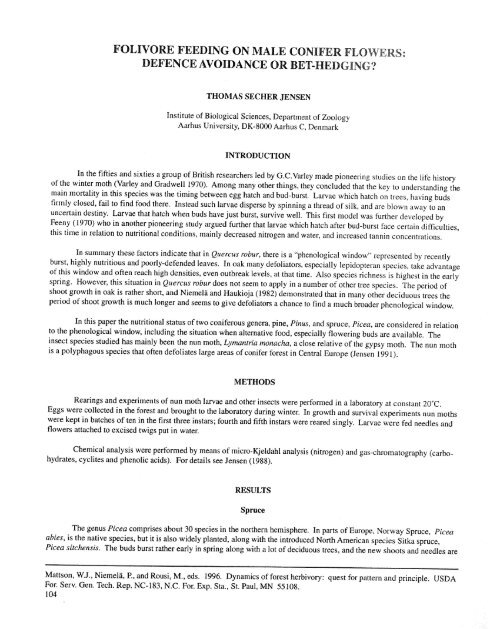View or print this publication - Northern Research Station - USDA ...
View or print this publication - Northern Research Station - USDA ...
View or print this publication - Northern Research Station - USDA ...
You also want an ePaper? Increase the reach of your titles
YUMPU automatically turns print PDFs into web optimized ePapers that Google loves.
FOLIVORE FEEDING ON MALE CONIFER FLOWERS °<br />
DEFENCE AVOIDANCE OR BET-HEDGING?<br />
THOMAS SECHER JENSEN<br />
Institute of Biological Sciences, Department of Zoology<br />
Aarhus University, DK-8000 Aarhus C, Denmark<br />
INTRODUCTION<br />
In the fifties and sixties a group of British researchers led by G.C.Varley made pioneering studies on the life hist<strong>or</strong>y<br />
of the winter moth (Varley and Gradwell 1970). Among many other things, they concluded that the key to understanding the<br />
main m<strong>or</strong>tality in <strong>this</strong> species was the timing between egg hatch and bud-burst. Larvae which hatch on trees, having buds<br />
firmly closed, fail to find food there. Instead such larvae disperse by spinning a thread of silk, and are blown away to an<br />
uncertain destiny. Larvae that hatch when buds have just burst, survive well. This first model was further developed by<br />
Feeny (1970) who in another pioneering study argued further that larvae which hatch after bud-burst face certain difficulties,<br />
<strong>this</strong> time in relation to nutritional conditions, mainly decreased nitrogen and water, and increased tannin concentrations.<br />
In summary these fact<strong>or</strong>s indicate that in Quercus robur, there is a "phenological window" represented by recently<br />
burst, highly nutritious and po<strong>or</strong>ly-defended leaves. In oak many defoliat<strong>or</strong>s, especially lepidopteran species, take advantage<br />
of <strong>this</strong> window and often reach high densities, even outbreak levels, at that time. Also species richness is highest in the early<br />
spring. However, <strong>this</strong> situation in Quercus robur does not seem to apply in a number of other tree species. The period of<br />
shoot growth in oak is rather sh<strong>or</strong>t, and Niemel/i and Haukioja (1982) demonstrated that in many other deciduous trees the<br />
period of shoot growth is much longer and seems to give defoliat<strong>or</strong>s a chance to find a much broader phenological window.<br />
In <strong>this</strong> paper the nutritional status of two coniferous genera, pine, Pinus, and spruce, Picea, are considered in relation<br />
to the phenological window, including the situation when alternative food, especially flowering buds are available. The<br />
insect species studied has mainly been the nun moth, Lymantria monacha, a close relative of the gypsy moth. The nun moth<br />
is a polyphagous species that often defoliates large areas of conifer f<strong>or</strong>est in Central Europe (Jensen 1991).<br />
METHODS<br />
Rearings and experiments of nun moth larvae and other insects were perf<strong>or</strong>med in a lab<strong>or</strong>at<strong>or</strong>y at constant 20°C.<br />
Eggs were collected in the f<strong>or</strong>est and brought to the lab<strong>or</strong>at<strong>or</strong>y during winter. In growth and survival experiments nun moths<br />
were kept in batches of ten in the first three instars; fourth and fifth instars were reared singly. Larvae were fed needles and<br />
flowers attached to excised twigs put in water.<br />
Chemical analysis were perf<strong>or</strong>med by means of micro-Kjeldahl analysis (nitrogen) and gas-chromatography (carbohydrates,<br />
cyclites and phenolic acids). F<strong>or</strong> details see Jensen (I988).<br />
RESULTS<br />
Spruce<br />
The genus Picea comprises about 30 species in the n<strong>or</strong>thern hemisphere. In parts of Europe, N<strong>or</strong>way Spruce, Picea<br />
abies, is the native species, but it is also widely planted, along with the introduced N<strong>or</strong>th American species Sitka spruce,<br />
Picea sitchensis. The buds burst rather early in spring along with a lot of deciduous trees, and the new shoots and needles are<br />
Mattson, W.J., Niemel_i, R, and Rousi, M., eds. 1996. Dynamics of f<strong>or</strong>est herbiv<strong>or</strong>y: quest f<strong>or</strong> pattern and principle. <strong>USDA</strong><br />
F<strong>or</strong>. Serv. Gen. Tech. Rep. NC-183, N.C. F<strong>or</strong>. Exp. Sta., St. Paul, MN 55108.<br />
104
















